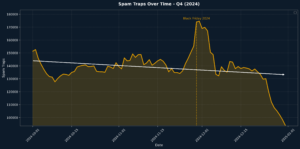Blog
Email Deliverability Around Black Friday: A Data-Based Comparison of Q4 2023–2024
The peak period of email marketing around Black Friday and holiday communications is a stress test for deliverability every year. Senders increase their sending frequencies, campaign volumes spike dramatically, and mailbox providers respond with stricter filtering mechanisms.
An analysis of data from our mailbox provider partners regarding the Inbox Placement Rate (IPR), Spam Complaint Rate (SCR) and spam trap hits for Q4 2023 and Q4 2024 shows: the impact of Black Friday is clearly measurable, and the trends point to new challenges for 2025.
Inbox Placement Rate: Short-term Increase Followed by a Drop

In Q4 2023 and Q4 2024, a similar pattern emerged, but with varying intensity:
- 2023: Around Black Friday, the IPR rose from approximately 71% to 74.5% – a short-term peak that levelled off again in the first week of December.
- 2024: The increase was stronger (from 70% to 75%), but the subsequent decline was also more pronounced: by mid-December, the delivery rate fell below 69%.
This dynamic suggests short-term optimisation ahead of the major sending days, but also an overload of reputation after the campaign peak.
Spam Trap Hits: A Significant Increase in 2024

A particularly revealing indicator is the development of spam trap hits:
- In 2023, the average level was around 80,000 hits, with a moderate increase to around 100,000 around Black Friday.
- In 2024, however, it started at a much higher level (over 130,000) and peaked at almost 180,000 hits on Black Friday – an increase of more than 60% year-over-year.
This indicates an increase in the activation of old or inactive addresses – possibly due to reactivated mailing lists or aggressive re-engagement campaigns.
Spam Complaint Rate: High Peaks and Growing Recipient Intolerance

The Spam Complaint Rate (SCR) also reflects the increased burden on the recipient base:
- 2023: The complaint rate remained largely stable at 0.06–0.07%, with a moderate increase in the week after Black Friday.
- 2024: The SCR rose to over 0.08% in November, with two significant peaks – directly around Black Friday and just before Christmas, when it reached nearly 0.09%.
This pattern suggests that recipients are more sensitive to repeated or inappropriate mailings, especially when multiple senders communicate simultaneously.
Overall Assessment: The Black Friday Paradox
Black Friday remains one of the most valuable mailing weeks of the year – yet the data reveals a growing paradox: the more campaigns are sent, the more risk indicators such as spam traps and complaints increase.

These developments illustrate that short-term campaign success is increasingly accompanied by long-term deliverability risks.
This highly active phase carries the risk of sustainable damage to reputation, which can take many weeks or months to recover from and thus result in a sustainable loss despite the short-term success.
Outlook: How Black Friday 2025 Could Develop
Several trends are emerging:
- Mailbox providers are increasingly relying on engagement-based filters.
- List hygiene and authentication are fundamental prerequisites.
- Consumer behaviour is changing, willingness to complain is rising.
- 2025 will be the year of segmentation strategy: smaller, more relevant target groups, tiered frequencies and preference centre strategies.
Recommendations for Senders
- Early preparation: technical review of SPF, DKIM, DMARC.
- List management: exclude old contacts; no re-engagement during peak periods.
- After Black Friday: Pause sending for 7–10 days or reduce frequency.
Conclusion
The data clearly shows that Black Friday remains a turning point for email deliverability. 2024 brought short-term success, but higher long-term risks. Those aiming to succeed in 2025 must send not more, but better – with smart planning, segmentation and a solid technical foundation.